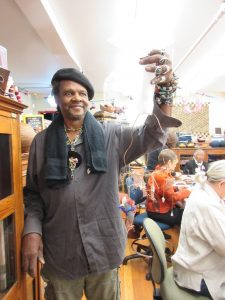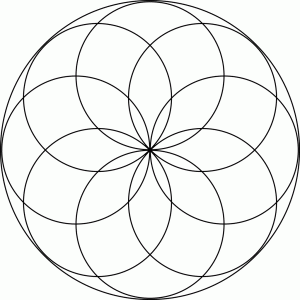 Much to my surprise and delight, outsider art superstar Lonnie Holley was in Vancouver last week. He came with the Gees Bend quilters (more about that later) to conduct an art workshop and perform with his band. (Who knew he was also a musician?) I became aware of Lonnie’s work some years ago through my personal journey in outsider art. I mainly knew about his sculptures, but happened to see a painting of his last year in New Orleans. (Dynamite. Absolutely gorgeous.) This year I got to meet him. And here is holding my sculptural creation.
Much to my surprise and delight, outsider art superstar Lonnie Holley was in Vancouver last week. He came with the Gees Bend quilters (more about that later) to conduct an art workshop and perform with his band. (Who knew he was also a musician?) I became aware of Lonnie’s work some years ago through my personal journey in outsider art. I mainly knew about his sculptures, but happened to see a painting of his last year in New Orleans. (Dynamite. Absolutely gorgeous.) This year I got to meet him. And here is holding my sculptural creation.
Lonnie’s biography can be found easily on the Internet, but he is happy to share the details of his life with people he meets. Lonnie, AKA The Sand Man, was the 7th of 27 children (!), born in Alabama in 1950. He told us that his art career sprung from a horrific event, when his sister’s two children died in a house fire. Not having enough money to buy headstones, Lonnie carved them himself from discarded material near the foundry. He says that after that he wasn’t able to stop creating and having seen him in action, I caught a glimpse of what he meant.
Lonnie showed his work to the Birmingham Museum of Art and they were immediately received by the director. Things snowballed from there – people came to see his yard full of sculptures and the outsider art world took notice. Thank heavens for those who recognized his artwork as more than bits of trash.
Like many outsider artists, Lonnie is prolific. We were asked to bring a collection of “personal things” to the workshop and without much introduction, Lonnie asked us to assemble something from the piles of material on the table. One person brought objects from her family, including old tools from her grandfather. Lonnie became absorbed in her personal story and what the objects had to tell. He spent a lot of time helping her hammer things together until a final sculpture took shape.  It was obviously a collection of ‘stuff’ that struck a chord with him. I was intrigued to watch the process of a sculpture coming together and got little done on my own project. In fact, he told us that it is the process and how it feels, not the end product that matters. This is something I have heard over and over (and over) from outsider artists that I have come to know.
It was obviously a collection of ‘stuff’ that struck a chord with him. I was intrigued to watch the process of a sculpture coming together and got little done on my own project. In fact, he told us that it is the process and how it feels, not the end product that matters. This is something I have heard over and over (and over) from outsider artists that I have come to know.
It is an important reminder to stop and smell the roses on your life’s journey.
I would never approach a superstar in the contemporary art world. I am intimidated in those settings and find myself shrinking into a corner, tongue-tied. (Remind me sometime to tell you about the time I thought* (*fantasized) that I saw Ai Wei Wei in an art museum in New York.) But it’s different with outsider artists. They are always approachable, interesting, and interested. So it was with Lonnie. He is talker, and likes to talk about what he is doing as he works on his art piece, tell stories about himself, and generally shoot the breeze.
Lonnie enjoys engaging with others and hearing what they have to say. He is kind, personable, and funny. Meeting him was another reminder that in the end, we are all just *people* with our own troubles, epiphanies, sorrows, triumphs, and memories. My personal story is different from yours, but we have all walked the same path at some point in our lives.
















